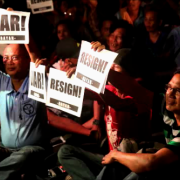HTI fire: Where are the 1,328 workers?
A FACT-FINDING mission has accused House Technology Industries (HTI), the Cavite provincial government and the Philippine Economic Zone Authority (PEZA) of covering up the real number of casualties at the massive February 1 Cavite factory fire.
In a press conference with the Makabayan bloc at the House of Representatives, the mission said 1,328 workers have yet to be accounted for by the company and its recruitment agencies.
The missing may have perished in the massive fire as survivors they interviewed revealed that many workers were trapped inside the burning building, the fact-finding mission said.
The Japanese company and Cavite government officials are also preventing survivors from recounting the events at official investigations, the mission revealed.
“The workers’ accounts and the DOLE’s (Department of Labor and Employment) report speak volumes. Where are the 1,328 workers?” the mission, led by Kilusang Mayo Uno (KMU), asked.
The mission also condemned Cavite Governor Crispin Remulla and PEZA Director General Charito Plaza for reporting there were only three casualties in the two-day fire.
“The claim that all workers have been accounted for is doubtful, as some workers, mostly contractual workers, (have) yet to report to their respective agencies,” the mission said.
“Without HTI’s full disclosure, doubts will linger and allegations of hiding the truth and evading full responsibility will continue,” the mission said.
The 40-member fact-finding mission was conducted last February 4 to 7 in six Cavite towns where the workers’ boarding houses are located, the two hospitals where the victims taken during the fire and around the Cavite Export Processing Zone (CEPZ).
Workplace safety violations
Mission participants also revealed major occupational health and safety standards violations by the Japanese company.
Nadia de Leon, spokesperson of the Institute for Occupational Health, Safety and Development said that HTI only had six or seven fire exits instead of the necessary 12 based on the number of its workers in the factory.
She revealed that survivors told them some fire exits were also locked.
“Exit stairs should lead directly to roads but HTI’s exits lead back to the buildings,” de Leon said.
“Windows were also screwed shut, forcing the workers to break (them) to escape the fire. Many jumped from the 3rd and 2nd floors of the building where women workers were stationed,” the mission report said.
Reluctance to be interviewed
In an interview, KMU executive vice president Joselito Ustarez revealed that DOLE investigators have yet to be allowed inside the factory to conduct thorough investigations.
Ustarez said DOLE’s report noted that 582 workers failed to log in at the start of their shift and the labor agency is yet to be informed of what happened to them.
“CEPZ, PEZA and the local government should produce the complete list of names of those unaccounted for as the public deserves to know the truth,” Ustarez said.
Members of the media are also barred from entering the economic enclave.
The mission noted the “unusual demeanor and reluctance of workers and survivors to be interviewed,” making their investigation difficult.
Ustarez said said 50 per cent of the 30,000 CEPZ workers are “contractual” and non-unionized.
HTI was among the biggest practitioners of contractualization at CEPZ, he said.
“HTI has six recruitment agencies it uses to hire contractual labor,” Ustarez added.
Kodao sources said that majority of the economic zone contractual workers are members of a church group that discourages its members to join unions.
The Makabayan bloc endorsed the mission’s findings to the House of Representatives Committee on Labor and Employment for a congressional investigation. (Raymund B. Villanueva)







